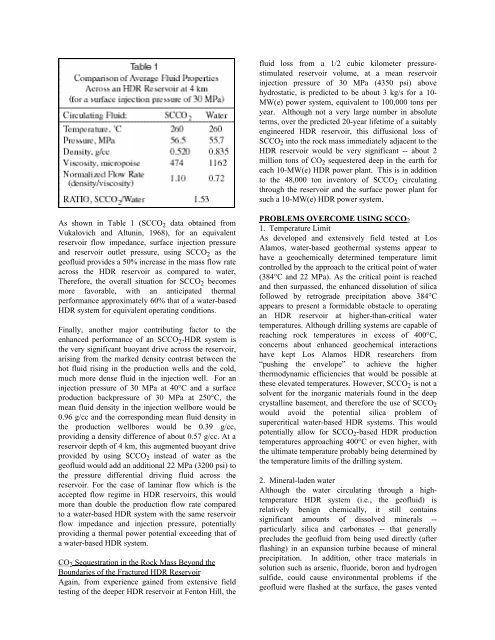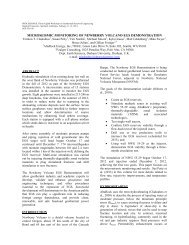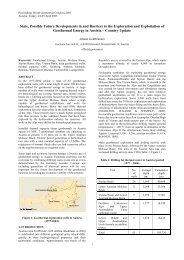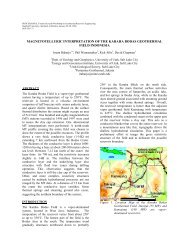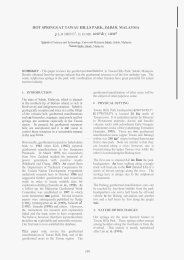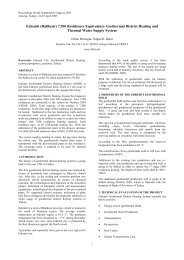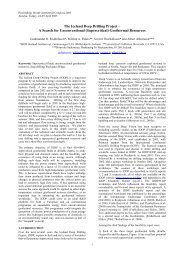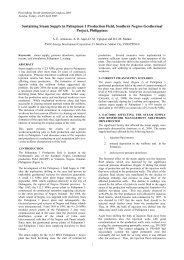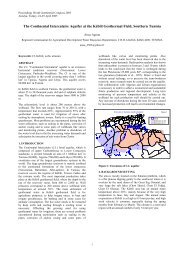A HOT DRY ROCK GEOTHERMAL ENERGY CONCEPT UTILIZING ...
A HOT DRY ROCK GEOTHERMAL ENERGY CONCEPT UTILIZING ...
A HOT DRY ROCK GEOTHERMAL ENERGY CONCEPT UTILIZING ...
You also want an ePaper? Increase the reach of your titles
YUMPU automatically turns print PDFs into web optimized ePapers that Google loves.
fluid loss from a 1/2 cubic kilometer pressurestimulated<br />
reservoir volume, at a mean reservoir<br />
injection pressure of 30 MPa (4350 psi) above<br />
hydrostatic, is predicted to be about 3 kg/s for a 10-<br />
MW(e) power system, equivalent to 100,000 tons per<br />
year. Although not a very large number in absolute<br />
terms, over the predicted 20-year lifetime of a suitably<br />
engineered HDR reservoir, this diffusional loss of<br />
SCCO 2 into the rock mass immediately adjacent to the<br />
HDR reservoir would be very significant -- about 2<br />
million tons of CO 2 sequestered deep in the earth for<br />
each 10-MW(e) HDR power plant. This is in addition<br />
to the 48,000 ton inventory of SCCO 2 circulating<br />
through the reservoir and the surface power plant for<br />
such a 10-MW(e) HDR power system.<br />
As shown in Table 1 (SCCO 2 data obtained from<br />
Vukalovich and Altunin, 1968), for an equivalent<br />
reservoir flow impedance, surface injection pressure<br />
and reservoir outlet pressure, using SCCO 2 as the<br />
geofluid provides a 50% increase in the mass flow rate<br />
across the HDR reservoir as compared to water,<br />
Therefore, the overall situation for SCCO 2 becomes<br />
more favorable, with an anticipated thermal<br />
performance approximately 60% that of a water-based<br />
HDR system for equivalent operating conditions.<br />
Finally, another major contributing factor to the<br />
enhanced performance of an SCCO 2 -HDR system is<br />
the very significant buoyant drive across the reservoir,<br />
arising from the marked density contrast between the<br />
hot fluid rising in the production wells and the cold,<br />
much more dense fluid in the injection well. For an<br />
injection pressure of 30 MPa at 40°C and a surface<br />
production backpressure of 30 MPa at 250°C, the<br />
mean fluid density in the injection wellbore would be<br />
0.96 g/cc and the corresponding mean fluid density in<br />
the production wellbores would be 0.39 g/cc,<br />
providing a density difference of about 0.57 g/cc. At a<br />
reservoir depth of 4 km, this augmented buoyant drive<br />
provided by using SCCO 2 instead of water as the<br />
geofluid would add an additional 22 MPa (3200 psi) to<br />
the pressure differential driving fluid across the<br />
reservoir. For the case of laminar flow which is the<br />
accepted flow regime in HDR reservoirs, this would<br />
more than double the production flow rate compared<br />
to a water-based HDR system with the same reservoir<br />
flow impedance and injection pressure, potentially<br />
providing a thermal power potential exceeding that of<br />
a water-based HDR system.<br />
CO 2 Sequestration in the Rock Mass Beyond the<br />
Boundaries of the Fractured HDR Reservoir<br />
Again, from experience gained from extensive field<br />
testing of the deeper HDR reservoir at Fenton Hill, the<br />
PROBLEMS OVERCOME USING SCCO 2<br />
1. Temperature Limit<br />
As developed and extensively field tested at Los<br />
Alamos, water-based geothermal systems appear to<br />
have a geochemically determined temperature limit<br />
controlled by the approach to the critical point of water<br />
(384°C and 22 MPa). As the critical point is reached<br />
and then surpassed, the enhanced dissolution of silica<br />
followed by retrograde precipitation above 384°C<br />
appears to present a formidable obstacle to operating<br />
an HDR reservoir at higher-than-critical water<br />
temperatures. Although drilling systems are capable of<br />
reaching rock temperatures in excess of 400°C,<br />
concerns about enhanced geochemical interactions<br />
have kept Los Alamos HDR researchers from<br />
“pushing the envelope” to achieve the higher<br />
thermodynamic efficiencies that would be possible at<br />
these elevated temperatures. However, SCCO 2 is not a<br />
solvent for the inorganic materials found in the deep<br />
crystalline basement, and therefore the use of SCCO 2<br />
would avoid the potential silica problem of<br />
supercritical water-based HDR systems. This would<br />
potentially allow for SCCO 2 -based HDR production<br />
temperatures approaching 400°C or even higher, with<br />
the ultimate temperature probably being determined by<br />
the temperature limits of the drilling system.<br />
2. Mineral-laden water<br />
Although the water circulating through a hightemperature<br />
HDR system (i.e., the geofluid) is<br />
relatively benign chemically, it still contains<br />
significant amounts of dissolved minerals --<br />
particularly silica and carbonates -- that generally<br />
precludes the geofluid from being used directly (after<br />
flashing) in an expansion turbine because of mineral<br />
precipitation. In addition, other trace materials in<br />
solution such as arsenic, fluoride, boron and hydrogen<br />
sulfide, could cause environmental problems if the<br />
geofluid were flashed at the surface, the gases vented


